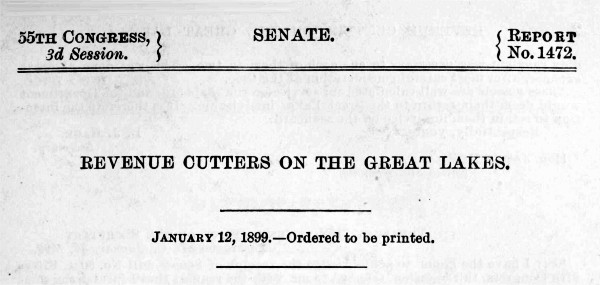Revenue Cutters on the Great Lakes
55 Congress 3rd Session
SENATE
Report No 1472

January 12, 1899 — Ordered to be printed.
Mr. McMILLAN, from the Committee on Commerce, submitted the following REPORT. [To accompany S. 5094.]
The Committee on Commerce, to whom was referred the bill (S. 5094) to provide for the construction of three revenue cutters for service on the Great Lakes, make a favorable report thereon.
At the outbreak of the war with Spain the Great Lakes were provided with suitable vessels for the revenue service in those waters. The exigencies of the war, however, were such as to make it imperative to go to the great expense of taking the three new vessels, the Algonquin, the Onondaga, and the Gresham, to the seaboard through the St. Lawrence canals. The Atlantic coast is so ill provided with revenue cutters that the Department deems it best and most economical to keep the three vessels on the coast instead of returning them to the lakes. This will necessitate the construction of new vessels for the inland waters.
The necessity for adequate revenue service on the Northern lakes will readily be appreciated from the statement made by the Commissioner of Navigation in his annual report for 1897, that “our lake fleet alone is greater than that of any foreign nation except Great Britain or Germany.” The three principal ship-owning States are New York, Michigan, and Ohio, the last two wholly lake States and the first one partly so.
The bill was referred to the Treasury Department, and the following letters explain the situation and the reason for the amendments:
TREASURY DEPARTMENT, OFFICE OF THE SECRETARY,
Washington, D. C., December 23, 1898.
Sir: I have the honor to acknowledge the receipt of your letter of the 17th instant, requesting to be informed what disposition has been made of the revenue cutters that were constructed recently for service on the Great Lakes, and whether it is the intention to send those cutters back to the lakes at the opening of navigation in 1899, or whether it is the intention of the Department to use them permanently on the Atlantic.
The revenue cutters Gresham, Algonquin, and Onondaga were ordered to the sea-board as an exigency of the late war, and in order to bring them through the Canadian canals it was necessary to cut each of them in two. This was done at great expense, after most careful consideration at the time.
These vessels are well calculated for service on the seaboard, and the Department would deem their return to the Great Lakes inadvisable. It is therefore the intention to retain them in service on the seaboard.
Respectfully, yours,
L. J. Gage, Secretary.
Hon. JAMES McMILLAN,
United States Senate.
TREASURY DEPARTMENT, OFFICE OF THE SECRETARY,
Washington, D. C., January 10, 1899.
Sir: I have the honor to acknowledge the receipt of Senate bill No. 5094, Fifty-fifth Congress, third session, referred to me with the request that I furnish the committee with such suggestions as I may deem proper touching the merits of the bill and the propriety of its passage.
The bill is "to provide for the construction of three revenue cutters for service on the Great Lakes, said steamers to take the places of the revenue cutters Gresham, Algonquin and Onondaga, which were ordered to the seaboard as an exigency of the late war."
Before the Gresham was built, there were two cruising cutters on the Great Lakes — the Johnson, at Milwaukee, and the Fessenden, at Detroit. As soon as the Gresham was finished and stationed at Milwaukee, the Johnson was sold, still leaving two vessels on the Great Lakes. Then the Algonquin and Onondaga were built, and all three of the new vessels (Gresham, Algonquin, and Onondaga) were ordered to the seaboard to be placed in cooperation with the Navy in the war with Spain.
As soon after the war closed as the vessel could be made available, the revenue cutter Morrill was sent to Milwaukee to take the place of the Gresham, thus making two vessels now in service on the Great Lakes. Had the Gresham, Algonquin, and Onondaga remained on the Great Lakes, there would have been four cutters there — enough to meet the requirements of the service.
With two additional vessels instead of three, as proposed by the measure under consideration, the work of the service on the lakes can be efficiently done. I think vessels of about 500 tons, having less draft of water and not so long as the vessels referred to above, would be better adapted to service on the lakes, besides reducing the cost considerably.
I would therefore recommend that the bill be amended to provide for two vessels, at a total cost for each not to exceed $165,000, as indicated in the inclosed copy of the bill.
Respectfully, yours,
L. J. Gage, Secretary.
The CHAIRMAN COMMITTEE ON COMMERCE,
United States Senate.
